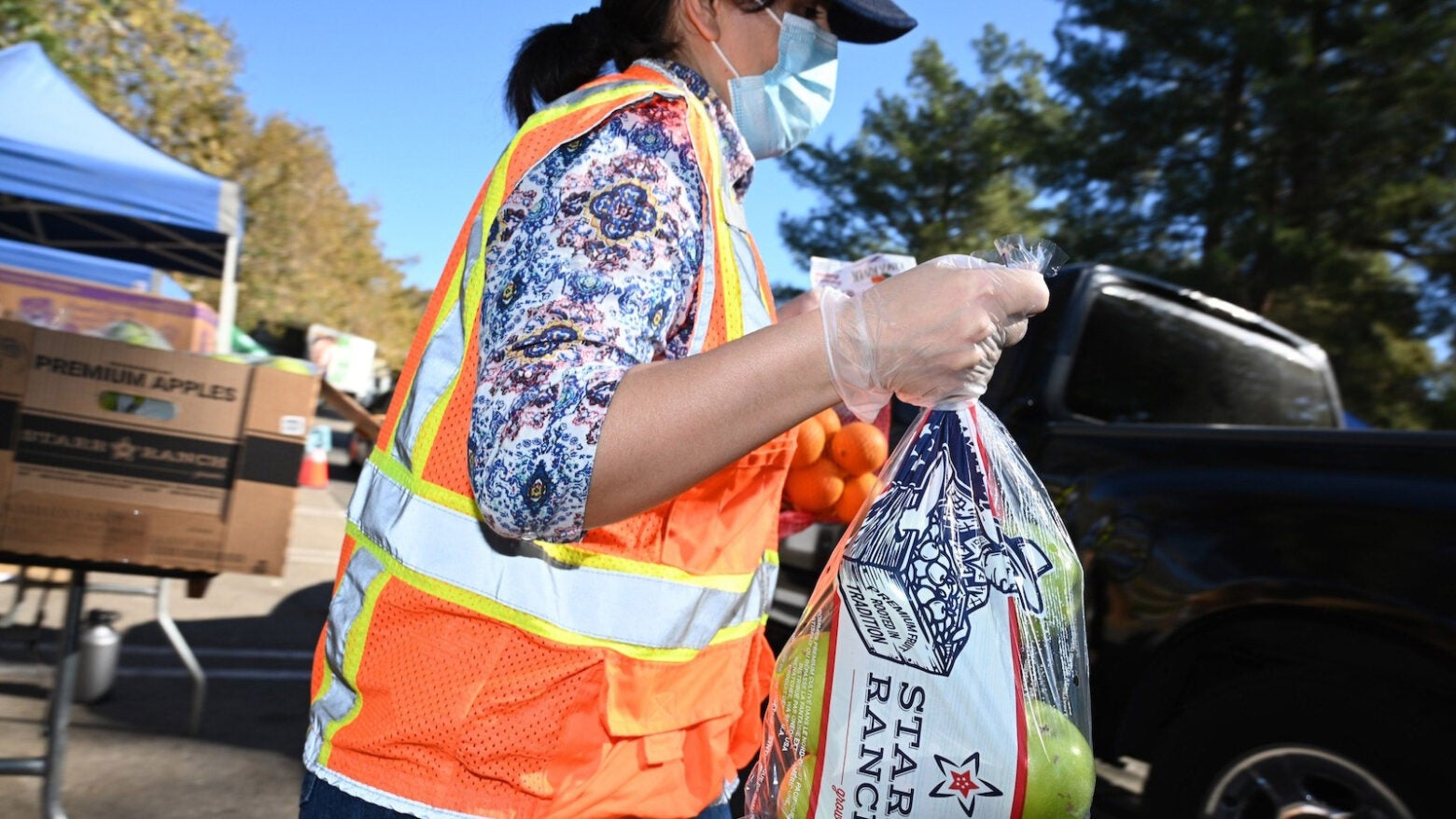
Feature
Food banks are an unlikely line of defense during heat waves
This story was originally published by Grist. Sign up for Grist’s weekly newsletter here.
On a Tuesday morning in mid-August, Mary Hynes was blasting her air conditioning. Hynes has walking problems, and she said she’s passed out “a couple of times” in the past. The issue went away after having her pacemaker adjusted, but it was enough to make her nervous about leaving her apartment in the Chelsea neighborhood of Manhattan. And then New York experienced a particularly hot summer with multiple heat waves, making her even less likely to go outside.
“Thank God for these guys,” she said, referring to the volunteer dropping off her weekly meals. Hynes is one of more than 20,000 New Yorkers 60 and older who receive meal deliveries from Citymeals on Wheels, a nonprofit organization founded in 1981 to fill the gaps in the city’s public meal assistance program for older, homebound New Yorkers. Her experience is an example of how, during heat emergencies, food assistance can provide a lifeline to vulnerable communities. “I didn’t think they were going to do deliveries because of the heat” at one point this summer, she said, “and I would’ve understood.”
For older adults living with disabilities or mobility issues, heat can compound the challenges of getting outside, getting groceries, and cooking for oneself. By delivering meals during bouts of extreme weather, including heat waves, food distribution organizations like Citymeals serve as a line of defense against the worst of climate impacts.
“Emergencies have become a sweet spot for us,” said Beth Shapiro, the CEO of Citymeals.
Sign up for Harvard Public Health
Delivered to your inbox weekly.
New York City’s Department for the Aging facilitates home-delivered meals for older New Yorkers who aren’t able to prepare their own meals, but only on weekdays. “The city funds meals Monday through Friday, and our founder believed that people should eat every day of the week, as we still do,” said Shapiro. In addition to weekend and holiday service, Citymeals, which partners with 30 senior centers in all five boroughs of New York City, also delivers food to older adults during localized emergencies. To qualify for Citymeals, recipients must be 60 or older and have a physical or mental health condition that prevents them from shopping for food or cooking regularly for themselves.
Citymeals volunteers and staff have delivered meals during major disasters—for example, 2012’s Hurricane Sandy, which flooded lower Manhattan, damaged buildings, and left hundreds of thousands without power. But extreme heat acts on vulnerable populations in ways that are more subtle, but just as dangerous. For adults 65 and older, living with certain illnesses, or taking certain medications, may impact the body’s ability to tolerate increases in temperature. Older adults with cardiovascular problems and other illnesses that can cause weakness are more susceptible to heat-related illness. Additionally, the social isolation that many older adults experience can become life-threatening during a heat wave. Home meal deliveries are one way to check in on older folks during heat emergencies—and as climate change makes summers hotter and hotter, the need for such high-touch services is growing.
“One of the things we talk about during heat events is checking on your neighbor,” said Heidi Brown, professor and program director of epidemiology at the University of Arizona’s college of public health. Volunteers bringing food to homebound people can help to break up the social isolation that they face. For example, volunteers can observe how a meal recipient appears on a hot day, check for signs of heat-related illness, and ask if they have enough water or any trouble cooling their home. (Citymeals instructs volunteers who observe serious problems to contact the meal recipient’s case manager.) Checking in may not be the explicit “mandate” of meal on wheels organizations, said Brown, “but that is a piece of what they’re doing. They’re bringing resources, making sure that that person is OK. And if not, reaching out and getting them to medical resources, getting them to a cooling station, or making sure they know where cooling stations are.”
The volunteer serving Hynes’ building said one thing he might pay attention to is whether a meal recipient has AC running or not. Even during a heat wave, it isn’t a given: Citymeals recently partnered with the City University of New York’s Urban Food Policy Institute to survey recipients of meal assistance services for older adults, including Citymeals. Almost half of the respondents reported experiencing food insecurity in the last 12 months, and over 60 percent were living on less than $15,000 a year.
“If I’m living on that, am I able to buy food, pay for medicine, turn on an air conditioner if I have it?” said Shapiro.
In addition to exacerbating financial burdens, extreme heat can complicate mobility issues for older people facing hunger. “Which makes sense,” said Michael Flood, the president and CEO of the Los Angeles Regional Food Bank. “None of us want to go out when it’s 98 degrees.” Across California, the heat in July shattered records and became the state’s hottest month on record. For Los Angeles, the most brutal heat of the summer is yet to come: This week, Southern California is expecting its longest and hottest heat wave of the summer.
The COVID-19 pandemic made the Southern California food bank more aware of how public health crises impact older adults’ mobility and ability to access food distribution hubs. Now, the organization delivers groceries to low-income people 60 or older.
Older adults aren’t the only population who experience heightened need for food banks and meal delivery services during extreme weather events. Unhoused people and families with children may also come to rely on food assistance programs more when there is a heat wave.
The Silver Lake Community Church in L.A. has a food pantry program that was designed with the needs of homeless folks in mind. When it’s really hot outside, unhoused people may decide not to come to the church for food assistance, said office administrator Stephanie Young. But volunteers will also pick up folks from wherever they’re staying and bring them to the church for programming, whether that’s the food pantry or the church’s shower program.
Homeless individuals who attend a free breakfast program at the St. Francis Center in downtown L.A. might stay and chat with other community members on particularly hot days, enjoying the center’s AC, according to programs director Cesar Argueta.
The summer also presents a twofold challenge for food-insecure families, especially those with children. “We see hunger spike a lot in the summer,” said Celia Cole, the CEO of Feeding Texas, a nonprofit dedicated to fighting hunger in the country’s second-largest state by population, “because what happens is those kids get out of school where they would have access to free breakfast and free lunch.” During the COVID-19 pandemic, Congress granted waivers that expanded schools’ and community groups’ ability to offer free meals to young people during the summer months, but those waivers expired in 2022. There are currently no sites in Texas offering free meals and snacks to children via the U.S. Agriculture Department’s Summer Food Service Program, according to the latest data listed on the program’s website.
“At the same time,” Cole added, “people’s utility bills are soaring,” which reduces the income they have available for groceries.
Cole pointed out that there can be many barriers to food access—for example, many people don’t apply for food stamps because they don’t realize they’re eligible, or because they may feel a sense of stigma around accepting government benefits. However, Cole said the root cause of hunger is most often wealth inequality and the high cost of living. “Getting people connected to all the benefits they’re eligible for is the first step in dealing with the food part of the problem,” she said. “But at the end of the day, the underlying problem is the money problem.”
In practice, disability, financial need, and climate impacts can all strike unexpectedly or all at once—and they can all make it harder for people to get the nutrition they need. Rubem Dasilva, a New Yorker who started receiving deliveries from Citymeals during the pandemic, said the service has helped him a lot. The 79-year-old, who lives not far from the theater district in Manhattan, has trouble affording groceries. And he avoids the matinee crowds on Wednesdays and Sundays for fear of getting jostled by pedestrians, making it harder to go to the grocery store. “I’ve been bumped like three or four times,” he said.
So the food program has been a lifesaver. “The meals are just great,” he said. “I am so grateful.”
For Dasilva, his mobility concerns do not prevent him from attempting to live life to the fullest. “I am very adventurous,” he said. “When the weather is great, I go to Central Park. I take my favorite form of travel, which is the Staten Island Ferry.” But even he has his limits. “When it’s too hot outside? I stay home.”
Photo: Grist / Getty Images


